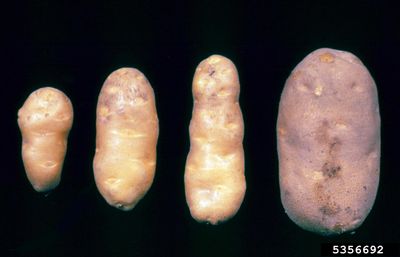Symptoms of Potatoes with Spindle Tuber Viroid
Spindle tuber of potato disease is a pathogen whose main host is potatoes, but which may also affect tomatoes and solanaceous ornamentals. No obvious symptoms are observed in potatoes with mild strains of the disease, but severe strains are another story. With severe infections, potato foliage will be spindly with overlapping leaflets, sometimes upward rolling, often twisted and wrinkled. Leaves at ground level are often in an upright position rather than those in healthy plants which rest on the ground. Overall, plants will be stunted. Tubers may have any one of the following abnormalities:
elongation, cylindrical, spindle, or dumb-bell shape prominent eyes surface cracking small size
Some cultivars with potato spindle tuber develop swellings or knobs and are severely deformed. With each generation, the foliage and tuber symptoms become more pronounced. Symptoms of spindle tuber viroid in potatoes may be confused with those of nutrient imbalances, insect or spray damage, or other diseases. Symptoms of the disease are more obvious during warm weather combined with full sun exposure.
How to Control Spindle Tuber Viroid in Potatoes
In order to learn how to manage this disease, it helps to know how it is transmitted – usually by contact between healthy and diseased plants via mechanical equipment like tractors or garden tools, and animal or human interaction with the plant. The initial infection of the viroid into the potatoes is through infected seed tubers. The secondary infection occurs through contact mentioned above. Transmission can also occur through pollen but only to pollinated seeds, not to the parent plant. Aphids may also transmit the viroid, but only when potato leafroll virus is present as well. To control spindle tuber of potato, use only certified tuber seed. Practice good crop sanitation. Wear sanitary gloves of vinyl or latex when handling infected plants and then dispose of them before moving on to healthy plants. Remember, plants may be infected but not showing symptoms. They are still disease carriers, so practicing sanitary garden habits should be consistent. Garden tools should be sanitized in a 2% solution of sodium hypochlorite or a similar disinfectant. Clothing can pass the infection from plant to plant, so be sure to change your clothing and shoes if you have been working amongst diseased plants. There are no biological or chemical controls for spindle tuber of potatoes. Potatoes that are infected with the disease and plants nearby that may be infected should be removed and either burned or buried deeply.
